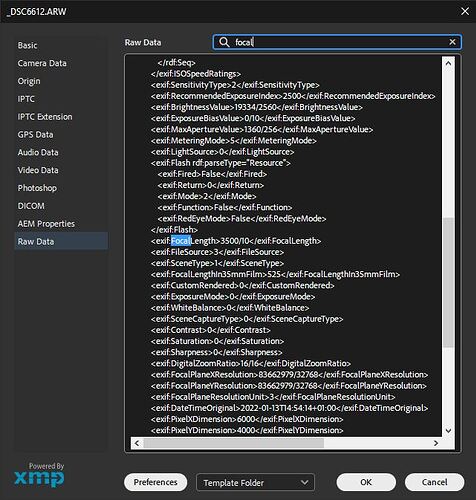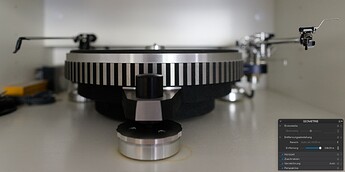DxO just like anybody else is offering crude optics corrections that is you have just few sets of parameters corresponding to few limited focusing distance ranges… apparently the assumption is that practically no optics needs different set of corrections past that focusing distance (128m = infinity in DxO opinion), so when theY (DxO) can’t get ( don’t want in case of .ARW, can’t in case or .RAF, etc ) focusing distance from a raw file they put 128m in DOP file … and it seems that in real life DxO does not supply any different optics correction parameters past something well below 128m ( can be like 20m-infinity, or 40m-infinity, etc )
A6400 and a6000
see my notes in the other topic about the raws from those 2 cameras
I downloaded A6400 raw files from dpreview and everything is working , except indeed for some camera + lenses combos DxO PL6 does not show “Focusing Distance” tool ( for example A6400 + Sigma 30/1.4 “Focusing Distance” tool is shown – but for Zony E24/1.8 or for FE24/1.4 GM it is not - DxO modules exist for all lenses in this example )
But the script does correctly fixes DOP files and for combos where the tool is shown you will see the updated correct focusing distance when you open DxO PL6 again in “Focusing Distance” tool
I suggest you file a case with DxO PL6 to fix the matter
- get them to use available actual focusing distance from .ARW always instead of defaulting to infinity
- make it possible for users to opt to see “Focusing Distance” tool always ( if so users wish to see )
- challenge them why their optics correction defaults to using only the infinity distance for a number of supported lenses w/o any option for a user to correct manually in DxO PL6 UI
- stop being stupid and let people opt to use manufacturers optics correction data if they can’t get focusing distance from Fuji Raw files
Sorry not working for me errers
t line:7 char:4
- FOR /F “tokens=*” %%v IN (‘exiftool -b -FocusDistance2 %1’ ) do ( SET …
- ~
Missing opening ‘(’ after keyword ‘for’.
+ CategoryInfo : ParserError: ( , ParentContainsErrorRecordException
, ParentContainsErrorRecordException
+ FullyQualifiedErrorId : MissingOpenParenthesisAfterKeyword
strong text
This has been going on since 2020 I have found when DXO cut the distance reading without telling Sony lens users. Though from what you have found what distance they were reading before is unknown.
In this it emerged “Focusing distance is in ‘Focus Distance 2’ entry (which is a calculation, not a real tag) but we don’t use it for now on this camera.
When we will use it we will announce it.”
At that stage V3 still read distance but they changed modules latter and V3 lost distance as well thereafter.
Then there was thread I started
and contribution’s made it clear as with the earlier thread there was a wide range of problem Sony cameras and lenses.
In here Marie admitted “we don’t read focus for all Sony A, we have some retrofit to do for A7 of generation I, II and III.
We haven’t done it yet because it require to modify DxO Optic modules as well and everything is a bandwidth question.”
It was this thread you join at but clearly it’s a known issue that DXO are ignoring (as I fear they do with too many problems). Since this thread was started they have effectively withdrawn all real interaction with users via the forum. Support appears to be no more knowledgeable than us as to what’s going on. They asked me if the distance issue had been resolved and just passed it back to the developers again. I fear the people who make the effective decisions in DXO have fully removed themselves from the users which again I fear could create problems for the products. But the distance issue for CR3 and Sony A is an example of this refusal to deal with old isues but add new marketing layers, the old Corel Draw strategy.
Tested a few files written by a Canon EOS M6 using the (old) Canon EF 100mm Macro lens and found, that these files had FocusDistance tag values with 1cm (0.01m) precision, at close-up and macro distances.
As far as I’ve tested, distance entries do depend on body/lens combination and more.
Let’s consider a zoom lens. It should also report focal length in addition to distance. I did not expect the values to be precise to 0.01, but rather to show ranges instead…and I also found individual files that had no entry for FL, even though other files of a series of photos taken with the same body and lens had. Welcome to the metadata desert of the real!
the formula to calculate ‘Focus Distance 2’ from a “real” tag ‘Focus Position 2’ and focal length and sensor format was / is known, so that was a lame excuse !
Its a mess they have created a product based on lense corections but failed to creat the needed way of geting the basic data from the RAW imiges to always use the correction data. As noname just pointed out the excuse originnly given for droping Sony A distance was “a lame excuse” PL not reading distance from Sony ARW - #50 by noname
According to the manual found on DXO website, it says this:
Focal length and focusing distance
The lens focal length and focusing distance of a photo are recorded in the EXIF data of your images. However, this information is not always accurate. For example, different but close positions of the focal length ring (say, 17 and 18 mm) could result in the same value (say 18 mm) being recorded in the EXIF data. In this case, the distortion correction may be less than optimal. In the same manner, the focusing distance might be recorded in the EXIF data with insufficient precision, and similarly lead to an imprecise correction. In both cases, to improve the effectiveness of the optical corrections, you can provide more accurate values in one (or both) of the sliders that appear in the Geometry palette:
Focal length: Use the slider to specify the lens focal length.
Focusing distance: Select a range for the focusing distance in the drop-down menu, then fine-tune with the slider.
The Focal Distance and Distance focusing sliders are permanently displayed in the Mac version, and appear automatically in the PC version.
I would imagine the tool is there in case the results are not accurate or you want to manually change it.
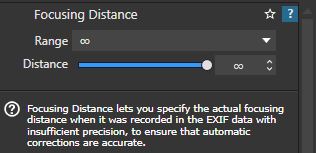
This is what I get in PhotoLab 6.7 with the correct optical module applied, but despite this I don’t see a problem of sharpness, only possibly a bit of diffraction, since its shot at f14 at telephoto end of 350mm.
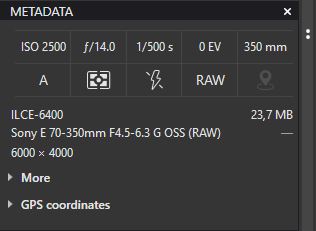
I checked in Adobe Bridge “file info” for raw metadata and I could not find any info on distance either. Only one reference to “focal”
ACDSee on PC also only lists some things from Sony in metadata.
Only thing that is curious is this anti-blur feature.
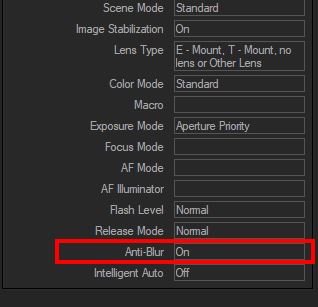
I don’t know what anti blur is, but Sony website lists this:
How to use the Anti Motion Blur function
The Anti Motion Blur feature reduces the camera shake when shooting a slightly dark scene or when using telephoto. In addition, the camera combines six shots at high sensitivity into one still image, so camera shake is reduced while preventing picture noise. This feature is also suitable for indoor shots without using the flash.
Follow the steps below to turn on the Anti Motion Blur feature.
Turn on the camera.
Press the Menu button.
Turn the control wheel to select the Shoot Mode displayed on the LCD screen.
Press the center button on the control wheel.
Turn the control wheel to select Anti Motion Blur.
Press the center button on the control wheel.
NOTES:
If you select Anti Motion Blur with RAW or RAW & JPEG, the image quality becomes Fine temporarily.
The shutter clicks six times and an image is recorded.
Reducing blur is less effective when shooting:
Subjects with erratic movement.
Subjects too close to the camera.
Subjects with a repeating pattern such as tiles, and subjects with little contrast such as sky, sandy beach, or lawn.
Subjects with constant change, such as waves or water falls.
When using a light source that flickers, such as fluorescent lighting, block noise may occur.
Maybe try to experiment shooting an image without OSS (Optical Stabilization) and check metadata to see if there is any difference.
Personally I would not worry about it too much, just see how the image looks. If its satisfactory sharp, keep it as is, if its not try to play with the sliders, but I would not worry about it much.
If its a bug, maybe it can be reported and confirmed and eventually fixed, but for now I would just shoot and see how it looks.
The image you shot does appear a bit softer than I would like to see. It is possibly a copy of the lens that is a problem, I don’t know, sometimes you can get a copy of the lens that is less sharp than it should be. Either way its usable . And you can further tweak it with other tools if you really need to.
It could be just that focal length and aperture. But with the help of lens sharpness and DeepPrime XD, you could get it to be sharp enough probably, even if its shot at 2500 ISO with a smaller APS-C sensor on Sony a6400.
there is nothing to imagine - with Sony .ARW raw files DxO PL6 simply does one of two things : either does not read properly provided focusing distance provided in raw file, but at least displays a proper tool in UI telling that distortion correction is applied as if lens was focused @ infinity ( but user can manually select other distances in UI ) and there is a manual workaround available where you can force DxO through modification of DOP file to use correct focusing distance and apply proper set of corrections –OR – defaults behind the scenes to “infinity” and does not tell user ( no option to see the tool and fix in UI ) - which also might be when they do have actually distortion correction in optical module ready for various focusing distances available ( but just one set of corrections ) and hence why they simply hide that
Looked through a bunch of files, here’s one of a turntable:
Let’s have a look at distance settings:

Notes
- Photo taken with a 24mm lens on a Canon FF body
- DPL sets distance to > 10m (see upper arrow)
- The blue part of the slider starts with an offset (lower arrow)
- When I select a specific/different range, the slider handle locates itself where the blue bar begins, “Distance” then says 0.75 m, but actual distance was about half that figure.
- Distance value = 0…as written in the Canon VRD section of metadata by Canon DPP software
My lesson learned
- Don’t use distortion correction unless necessary, e.g. with architectural or technical subjects
- If distortion correction is applied, check focal length and distance sliders - and adjust for lines to be really straight if possible.
I remember a software in which the developers were so bogged down by a cumbersome and obsolete architecture that they were no longer able to correct simple bugs, nor evolve the software at a decent pace. And that each new release brought a new batch of bugs, incomprehensible on apparently simple details. Bug fixes created new ones. Other bugs lasted years or were completely ignored despite user complaints.
Developers who had designed the program had left the team (disagreement on copyright), and the new developers couldn’t find their way around, to the point where some plugin developers were able to produce things that the software developers couldn’t do.
It was a more complex piece of software than this one, though. But changing team and gluing bits of code together without a suitable overall architecture has produced this result.
My son is a programer/project manager for a big US firm says this is all to common. Programs used by firms they have taken over hsve at times been less work to reprogram anew than to try to sort out all the programing problems and these are military ones as well. So if the problem exists with DXO its nothing new just how the system works and the resulting mess.
I redid a point and some tests concerning the “problem” of the focus distance for Sony cameras/lens!
I have been using Sony cameras for a long time, first in A mount, then in E(FE) mount.
It is well known that the focus distances with the Sonys have always been a problem since they are rarely “found” by PL.
But the polemical turn of the last interventions seems to me a little excessive!
PhotoLab exports of raw Sony ARW, I obviously have a few thousand. Although I would obviously prefer the distance to be recognized automatically, I never had any problems with the distortion correction.
From my tests, I deduce (but it is also obvious) that the distortion correction depends on:
- essentially the lens (and its focal length for zooms): incidence 95 to 100%, personal estimate!
- and for a variable part (low to very low) of the focus distance. Including of course for short focal lengths and/or with significant and complex distortions. Incidence 0 to 5%, always personal estimate!
Regarding lenses for which DxO does not display the focusing distance setting, I am not sure that DxO uses (or calculates) the distance (FocusDistance2) from the metadata.
I checked for my lenses, only long focal lengths: 70mm and more, and a macro lens. I note that the distortion linked to the focal length is low to very low. Suffice to say that the impact of the focus distance is totally zero. Of course, this is also verified by comparing the PL6 exports with the exports from Sony’s demosaicing software: Edit, which we can assume knows how to read its own metadata!
My conclusion is therefore that for these lenses, whether or not DxO reads the distance, this has no practical effect on the distortion correction… So DxO can very well ignore the distance for these lenses, I don’t I don’t see anything against them.
For lenses that display the focusing distance setting (most of mine):
-
DxO obviously does not use FocusDistance2
-
FocusDistance2 seems to not match actual focus distance perfectly, especially at short distances. I couldn’t find any explanation…
-
In .dop files, the DistortionFocus value can be present twice:
– at the start of the file, this is the default value applied when opening the raw, generally 128 (= infinity) with the DxO Standard preset. For my case it is 50 (= 50m) which is the value of my personalized preset.
– at the end of the file, the new value entered at the cursor, if there has been a modification. -
The focusing distance ranges are different according to each lens, which implies adapted distance settings.
-
From a certain focus distance, variable according to the lens (distance which can be quite short: 1 to 2m, or rarely longer: 10 to 20m), nothing changes for the distortion correction. It may seem odd, but it’s just a reality that can be easily verified without reverse engineering. By having a real line at the edge of the image, from the moment it is perfectly corrected in distortion for a given distance, it remains so regardless of the higher distance setting on the slider. This relativizes the importance given to the focus distance “in real life”!
-
For very short focus distances and when the range drop-down list is large, it is better to enter a fairly precise distance.
-
In all other cases, it is not necessary to be precise about the distance to be entered, an estimate of the distance will always lead to a valid correction.
Again, it would be preferable for DxO to enter the metadata distance values directly.
In the meantime and for my photo practice, I have to enter the distances for a fairly limited number of images, the current value of 50m from my preset covering a majority of my photos taken. For example for my two most used zooms, this value of 50m covers all distances from 2m to infinity for perfect distortion correction.
Last point concerning the corrections of distortion of the manufacturers, Sony in this case, but it is probably valid for all.
In my tests, I was able to compare the “embedded” corrections used by the Sony and Adobe ACR software, with the DxO correction modules. And the advantage is clearly at DxO (and not only for the distortion)!
Sony writes optics correction for in ARW ( might not be the case with A-mount lenses though - but for purity E-mount lenses on E-mount body ), so any conclusion shall start with with what Sony itself writes for a given lens in raw file at various focusing distances … if Sony provides different corrections ( it is easy to access using for example Iridient S-Transformer that can convert that info into DNG tags) - resulting for example in visually different distortion correction and DxO does not ( basically providing a correction @ “infinity” ) then it is clear where fault is …
These lenses usually show less distortions compared to wide angle and wide zoom range lenses.
You can also check distortion data on dxomark.com (separate company, despite its name).
Real world example of distortion depending on both Focal Length and Focusing Distance settings:
- Focal Length wrong, Distance wrong, check the sliders and the bulge of the horizontal beams.
- Focal Length corrected, Distance wrong → horizontal beams are nicely straightened.
- Focal Length corrected, Distance wrong, check lower slider and the bulge of the horizontal beams.
- Focal Length corrected, Distance corrected → horizontal beams are nicely straightened.
Notes
- Corrections: FL and FD adjusted to be the same as when I took the photo with a 4x zoom lens.
- Distortions clearly depend on both FL and FD values.
- Distortions between FD set to 60m (DPL max.) and 4m (shooting distance) almost the same (nil).
- Summary: When a lens distorts as shown and with objects having straight lines, tweaking the FL and FD sliders can make a difference. Trust your eyes!
The correction module offers 5 distance ranges, which seems to be adequate for this lens. I also got the impression that corrections are interpolated between the ranges.
My Sony a 90mm macro has a wide range of changes
as you change distances
@John7 hello, Before the end of 2023 we will add focus reading for all Sony A7x / A1 / A9.
Optic modules will be updated to take it into account. Thank you for your understanding
before you in DxO rush to do that - remember that for some Sony models when 3rd party lenses are mounted the tag “FocusPosition2” in raw does not encode the distance ( to be calculated by a well known formula into the tag “FocusDistance2” ), but distance range ( to be mapped , totally not using the formula )
for example
using for example Canon EF 100/2 with Sigma MC-11 adapter on Sony A7R2 results in 5 values : 29 - 67 - 96 - 136 - 255 for tag 0x002d FocusPosition2
DxO PL6 has 6 distance ranges for EF 100/2 lens optics module = [ 0.9 - 1.57m ] + [ 1.57 - 3.03m ] + [ 3.03m - 12.51m ] + [ 12.51 - 40m ] + [ more than 40m ] + infinity …
so to automate focus detection “we” need to map 5 ranges provided by camera to 6 ranges in DxO optical module “C62333a”
0x002d FocusPosition2 = 255 it seems actually appears in a very-very close focus shots - extra testing needed to find out if that is the only case
0x002d FocusPosition2 = 136 it seems is a far distance focus : [ 12.51 - 40m ] + [ more than 40m ]
0x002d FocusPosition2 = 29 we can try [ 0.9 - 1.57m ]
0x002d FocusPosition2 = 67 we can try [ 1.57 - 3.03m ]
0x002d FocusPosition2 = 96 we can try [ 3.03m - 12.51m ]
PS: as DxO claims to test each actually physically each camera model x each lens - have fun !
